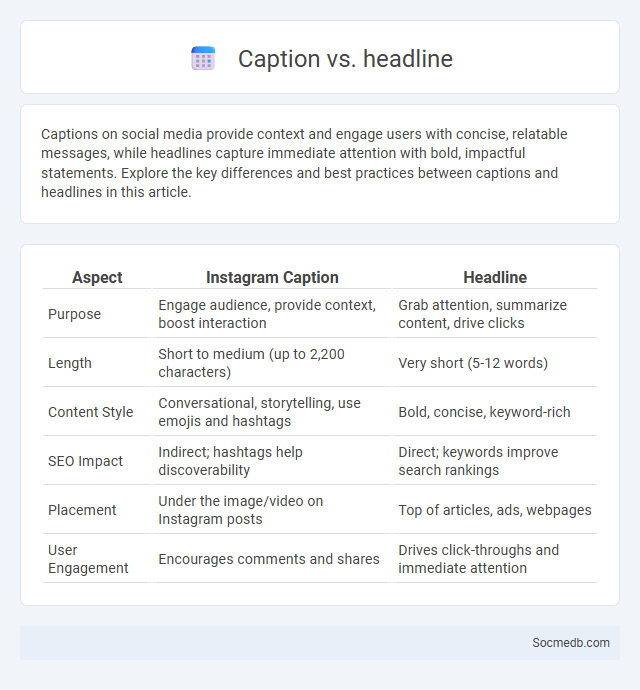
Photo illustration: caption vs headline
Captions on social media provide context and engage users with concise, relatable messages, while headlines capture immediate attention with bold, impactful statements. Explore the key differences and best practices between captions and headlines in this article.
Table of Comparison
| Aspect | Instagram Caption | Headline |
|---|---|---|
| Purpose | Engage audience, provide context, boost interaction | Grab attention, summarize content, drive clicks |
| Length | Short to medium (up to 2,200 characters) | Very short (5-12 words) |
| Content Style | Conversational, storytelling, use emojis and hashtags | Bold, concise, keyword-rich |
| SEO Impact | Indirect; hashtags help discoverability | Direct; keywords improve search rankings |
| Placement | Under the image/video on Instagram posts | Top of articles, ads, webpages |
| User Engagement | Encourages comments and shares | Drives click-throughs and immediate attention |
Understanding Captions: Definition and Purpose
Captions on social media are concise text descriptions accompanying images or videos that enhance content comprehension and engagement. Your understanding of captions helps convey context, evoke emotions, and encourage user interaction, making posts more accessible and impactful. Effective captions blend keywords with compelling storytelling to boost visibility and audience connection.
Exploring Headlines: Role and Significance
Headlines play a crucial role in social media by capturing attention and driving engagement through concise, compelling messaging. Effective headlines increase click-through rates, boost shares, and enhance content visibility across platforms like Facebook, Twitter, and Instagram. Your ability to craft clear, targeted headlines directly influences audience interaction and overall social media success.
Key Differences Between Captions and Headlines
Captions provide detailed context for images or videos on social media, engaging the audience with descriptive or narrative text that enhances content understanding and encourages interaction. Headlines serve as attention-grabbing summaries designed to quickly convey the main idea and entice users to read or click further. While captions offer supplementary information aligned with visual media, headlines prioritize brevity and impact for immediate user attraction.
When to Use a Caption vs Headline
Headlines are designed to grab immediate attention and summarize the main topic, ideal for paid ads or blog posts where quick engagement is crucial. Captions work best for social media posts by providing context, storytelling, or additional information that complements the visual content and encourages interaction. Effective use of headlines boosts click-through rates, while well-crafted captions increase user engagement and foster community connection.
Elements of an Effective Headline
Effective social media headlines capture attention with clear, concise language that highlights the core message. Incorporate strong keywords relevant to your audience and platform, ensuring the headline resonates with your target demographics. Crafting your headline with urgency or curiosity can significantly boost engagement and click-through rates.
Crafting Engaging Captions for Visual Content
Crafting engaging captions for visual content enhances your social media impact by connecting emotionally with your audience through concise storytelling and relevant keywords. Incorporate calls-to-action and relatable language to encourage interaction, boosting visibility and engagement rates. Your captions should complement the visuals, making your posts memorable and shareable across platforms.
Common Mistakes: Caption vs Headline Confusion
Many users confuse captions with headlines, leading to less effective social media posts. A headline should grab attention and summarize the main idea, while a caption provides context or encourages engagement. To maximize reach and interaction, you must craft headlines that hook viewers and captions that add value to Your content.
SEO Considerations for Headlines and Captions
Effective SEO for social media headlines and captions hinges on integrating relevant keywords that match user search intent while maintaining a natural and engaging tone. Incorporating location-specific terms or trending hashtags enhances discoverability and boosts organic reach across platforms like Instagram, Twitter, and Facebook. Crafting concise, compelling phrases aligned with target audience interests improves click-through rates and drives higher engagement metrics.
Creative Examples: Headlines and Captions in Action
Creative social media headlines like "Unlock Your Potential: 5 Tips to Boost Productivity Today" capture attention by addressing clear benefits. Captions such as "Turning dreams into reality, one post at a time #MotivationMonday" enhance engagement with emotional appeal and relevant hashtags. These examples demonstrate how strategic wording and targeted keywords improve visibility and user interaction across platforms.
Best Practices: Choosing Between Captions and Headlines
Effective social media strategies hinge on selecting the right format between captions and headlines to maximize engagement. Captions provide context and storytelling, enhancing user connection, while headlines capture attention quickly, driving immediate clicks. Analyzing audience behavior and platform algorithms informs the optimal balance for content visibility and interaction.
 socmedb.com
socmedb.com